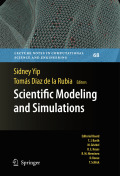
The conceptualization of a problem (modeling) and the computational solution of this problem (simulation), is the foundation of Computational Science. Thiscoupled endeavor is unique in several respects. It allows practically any complex system to be analyzed with predictive capability by invoking the multiscale paradigm—linking unit-process models at lower length (or time) scales wherefundamental principles have been established to calculations at the system level. The community of multiscale materials modeling has evolved into a multidisciplinary group with a number of identified problem areas of interest. SidneyYip and Tomas Diaz De La Rubia, the editors of this volume, have gathered 18 contributions that showcase the conceptual advantages of modeling which, coupled with the unprecedented computing power through simulations, allow scientists to tackle the formibable problems of our society. Showcases cutting edge applications of modeling and computations to formidable research problems relevant to our society INDICE: Editors’ Preface: Advocacy and Stewardship of Computational Science Historical introduction: A Retrospective on the Journal of Computer-Aided Materials Design, 1993 - 2007 Perspective in Extrapolative Procedures in Modelling and Simulation – the Role of Instabilities. Perspective in Extrapolative Estimations II: Characteristic Quantities and Dimensional Analysis. Perspective in Extrapolative Estimations III: Is the Modelling Accurate? Multiscale Modeling of Complex Physical Systems: Computation Meets Reality. Chemomechanics of Complex Nanocomposite Materials: Challenges and Opportunities in Predictive Kinetic Timescales. Tight-Binding Hamiltonian from First-Principles Calculations.Atomistic Simulation Studies of Complex Carbon and Silicon Systems Using Environment-Dependent Tight-Binding Potentials. First-principles Modeling of Lattice Defects: Insight into Structure -Properties Relations of Ice. Direct Comparison between Experiments and Computations at the Atomic Length Scale: A Case Study of Graphene. Science of Ultrafast Phenomena in Extreme Environments at the Intersection of Experiments and Simulation. Calculations of Free Energy Barriers for Local Mechanism of Hydrogen Diffusion in Alanate. Concurrent Design of Hierarchical Materials and Structures. Enthalpy Landscapes and the Glass Transition. Advanced Modulation Formats for Fiber Optic Communication Systems. Computational Challenges in the Search for and Production of Hydrocarbons. Multiscale Mechanics of Cells: From Molecules to Microstructure. Enveloped Viruses Understood via Multiscale Simulation: Computer-Aided Vaccine Design. Computational Modeling of Brain Cancer: Discrete, Continuum or Hybrid?
- ISBN: 978-1-4020-9740-9
- Editorial: Springer
- Encuadernacion: Cartoné
- Páginas: 395
- Fecha Publicación: 01/04/2009
- Nº Volúmenes: 1
- Idioma: Inglés
